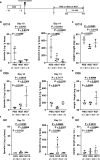Mouse IgA modulates human gut microbiota with inflammatory bowel disease patients
- PMID: 38874761
- PMCID: PMC11339086
- DOI: 10.1007/s00535-024-02121-y
Mouse IgA modulates human gut microbiota with inflammatory bowel disease patients
Abstract
Background: The imbalance of commensal bacteria is called dysbiosis in intestinal microflora. Secreted IgA in the intestinal lumen plays an important role in the regulation of microbiota. Although dysbiosis of gut bacteria is reported in IBD patients, it remains unclear what makes dysbiosis of their microflora. The intervention method for remedy of dysbiosis in IBD patients is not well established. In this study, we focused on the quality of human endogenous IgA and investigated whether mouse monoclonal IgA which binds to selectively colitogenic bacteria can modulate human gut microbiota with IBD patients.
Methods: IgA-bound and -unbound bacteria were sorted by MACS and cell sorter. Sorted bacteria were analyzed by 16S rRNA sequencing to investigate what kinds of bacteria endogenous IgA or mouse IgA recognized in human gut microbiota. To evaluate the effect of mouse IgA, gnotobiotic mice with IBD patient microbiota were orally administrated with mouse IgA and analyzed gut microbiota.
Results: We show that human endogenous IgA has abnormal binding activity to gut bacteria in IBD patients. Mouse IgA can bind to human microbiota and bind to selectively colitogenic bacteria. The rW27, especially, has a growth inhibitory activity to human colitogenic bacteria. Furthermore, oral administration of mouse IgA reduced an inflammation biomarker, fecal lipocalin 2, in mice colonized with IBD patient-derived microbiota, and improved dysbiosis of IBD patient sample.
Conclusion: Oral treatment of mouse IgA can treat gut dysbiosis in IBD patients by modulating gut microbiota.
Keywords: Dysbiosis; Gut microbiota; IgA; Inflammatory bowel disease.
© 2024. The Author(s).
Figures





Similar articles
-
Dynamic immunoglobulin responses to gut bacteria during inflammatory bowel disease.Gut Microbes. 2020 May 3;11(3):405-420. doi: 10.1080/19490976.2019.1626683. Epub 2019 Jun 16. Gut Microbes. 2020. PMID: 31203722 Free PMC article.
-
The oral-gut axis: Salivary and fecal microbiome dysbiosis in patients with inflammatory bowel disease.Front Cell Infect Microbiol. 2022 Oct 7;12:1010853. doi: 10.3389/fcimb.2022.1010853. eCollection 2022. Front Cell Infect Microbiol. 2022. PMID: 36275026 Free PMC article.
-
Bridging the gap between host immune response and intestinal dysbiosis in inflammatory bowel disease: does immunoglobulin A mark the spot?Clin Gastroenterol Hepatol. 2015 May;13(5):842-6. doi: 10.1016/j.cgh.2015.02.028. Epub 2015 Feb 25. Clin Gastroenterol Hepatol. 2015. PMID: 25725444 Review.
-
Dysbiosis in the Gut Microbiota in Patients with Inflammatory Bowel Disease during Remission.Microbiol Spectr. 2022 Jun 29;10(3):e0061622. doi: 10.1128/spectrum.00616-22. Epub 2022 May 9. Microbiol Spectr. 2022. PMID: 35532243 Free PMC article.
-
Current understanding of microbiota- and dietary-therapies for treating inflammatory bowel disease.J Microbiol. 2018 Mar;56(3):189-198. doi: 10.1007/s12275-018-8049-8. Epub 2018 Feb 28. J Microbiol. 2018. PMID: 29492876 Review.
Cited by
-
Role of mucosal IgA antibodies as novel therapies to enhance mucosal barriers.Semin Immunopathol. 2024 Nov 20;47(1):1. doi: 10.1007/s00281-024-01027-4. Semin Immunopathol. 2024. PMID: 39567378 Free PMC article. Review.
-
Functional Analysis of TAAR1 Expression in the Intestine Wall and the Effect of Its Gene Knockout on the Gut Microbiota in Mice.Int J Mol Sci. 2024 Dec 9;25(23):13216. doi: 10.3390/ijms252313216. Int J Mol Sci. 2024. PMID: 39684925 Free PMC article.
-
Gut microbiota as a new target for anticancer therapy: from mechanism to means of regulation.NPJ Biofilms Microbiomes. 2025 Mar 11;11(1):43. doi: 10.1038/s41522-025-00678-x. NPJ Biofilms Microbiomes. 2025. PMID: 40069181 Free PMC article. Review.
References
Publication types
MeSH terms
Substances
Grants and funding
LinkOut - more resources
Full Text Sources
Medical
Miscellaneous

